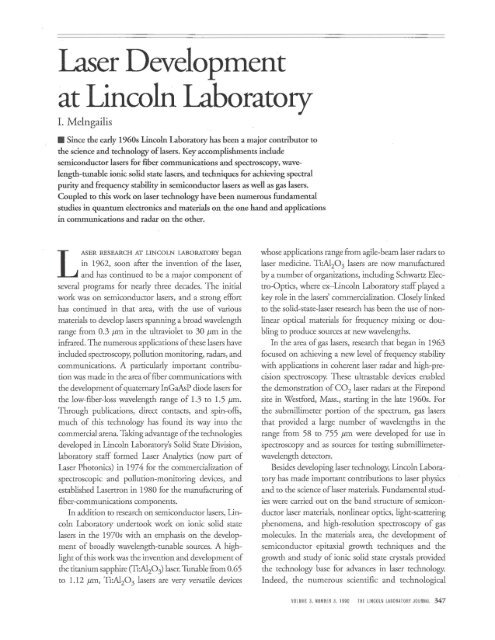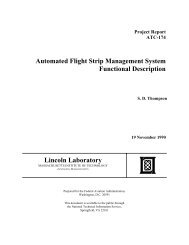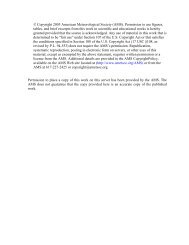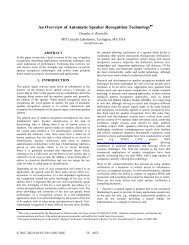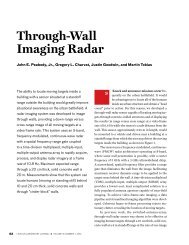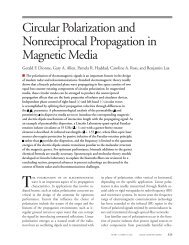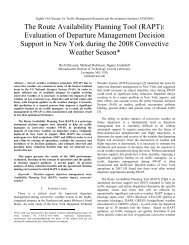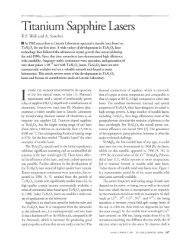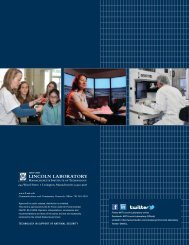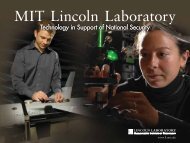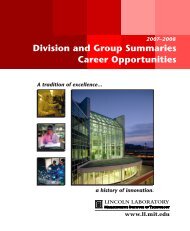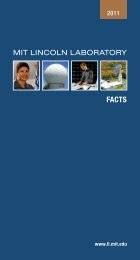Laser Development at Lincoln Laboratory - MIT Lincoln Laboratory
Laser Development at Lincoln Laboratory - MIT Lincoln Laboratory
Laser Development at Lincoln Laboratory - MIT Lincoln Laboratory
Create successful ePaper yourself
Turn your PDF publications into a flip-book with our unique Google optimized e-Paper software.
• MELNGAILIS<br />
<strong>Laser</strong> <strong>Development</strong> <strong>at</strong> <strong>Lincoln</strong> Labor<strong>at</strong>ory<br />
FIGURE 13. Two microchip lasers in a heterodyne experiment. (Note: The holes on the<br />
work table are 1 inch on center.)<br />
ionic solid st<strong>at</strong>e lasers in 1964 by using a bank ofGaAs<br />
diodes to pwnp a U 3 +:CaF 2 laser rod [52]. However,<br />
extensive employment of this technique did not take<br />
place until two decades l<strong>at</strong>er, when diode lasers had<br />
achieved the adequ<strong>at</strong>e wavelength control, high efficiency,<br />
room-temper<strong>at</strong>ure oper<strong>at</strong>ion, and long lifetimes th<strong>at</strong><br />
made such pwnping advantageous over lamp pumping.<br />
The present effort in this area includes tiny diodepwnped<br />
microchip lasers [53] (Figure 13) for applic<strong>at</strong>ions<br />
as stable narrow-line sources in communic<strong>at</strong>ions and<br />
fiber gyros and as efficient high-power transmitters for<br />
laser radars [54]. As an example ofthe l<strong>at</strong>ter applic<strong>at</strong>ion,<br />
the Solid St<strong>at</strong>e Division has developed a 10-W-averagepower<br />
diode-pwnped Nd:YAG laser th<strong>at</strong> is currently<br />
being used <strong>at</strong> the Firepond site in laser radar experiments<br />
for range measurements and for tracking space objects.<br />
Gas <strong>Laser</strong>s<br />
Applic<strong>at</strong>ions in laser radar and high-precision spectroscopy<br />
have driven most of the gas-laser development <strong>at</strong><br />
<strong>Lincoln</strong> Labor<strong>at</strong>ory. Starting in the mid-1960s, the Optics<br />
Division designed and built sealed-offCO 2 lasers for<br />
ultrastable oper<strong>at</strong>ion in the TEM oo mode for use as local<br />
oscill<strong>at</strong>ors and master oscill<strong>at</strong>ors in coherent 10.6-,um<br />
radars [55, 56]. Single-frequency output powers up to<br />
45 W and a yet-to-be-surpassed short-term frequency<br />
stability oft-.flf$. 1.5 x 10- 13 over 0.1 sec were obtained.<br />
Figure 14 is a photograph of one of the first sealed-off<br />
CO 2 lasers, which was built with four invar rods to<br />
reduce the cavity-length vari<strong>at</strong>ion with temper<strong>at</strong>ure. To<br />
achieve absolute frequency stabiliz<strong>at</strong>ion, a technique<br />
th<strong>at</strong> makes use of s<strong>at</strong>ur<strong>at</strong>ion resonance on the 4.3-,um<br />
wavelength fluorescence ofCO 2 was invented [57]. The<br />
technique enables absolute frequency reproducibilities<br />
to within 3 kHz in nine CO 2 isotopic species. Thus<br />
secondary frequency standards in the 8.9-to-12.3-,um<br />
wavelength range could be cre<strong>at</strong>ed with the Cs <strong>at</strong>omic<br />
clock used as a primary standard.<br />
For applic<strong>at</strong>ions in compact imaging radars, a modified<br />
ultrastable CO 2 laser th<strong>at</strong> can be oper<strong>at</strong>ed either in<br />
a CWor electronically Q-switched mode was built [58].<br />
Mini<strong>at</strong>ure transverse-electric <strong>at</strong>mospheric-pressure lasers<br />
with 10-W average powers (20 m] <strong>at</strong> 500 Hz) were designed<br />
and built for lidar measurement of <strong>at</strong>mospheric<br />
constituents [59]. In 1970 <strong>Lincoln</strong> Labor<strong>at</strong>ory was also<br />
the first to achieve the sealed-offoper<strong>at</strong>ion ofCO lasers,<br />
VOLUME 3. NUMBER 3. 1990 THE LINCOLN LABORATORY JOURNAL 355
which were used in various spectroscopic applic<strong>at</strong>ions<br />
and in the optical pumping of spin-flip Raman lasers<br />
(discussed in the following section).<br />
In the early 1970s a team in the Solid St<strong>at</strong>e Division<br />
made important contributions in the area of submillimeter-wavelength<br />
lasers. A CO 2 laser was used as a source<br />
for pumping gas molecules <strong>at</strong> frequencies far removed<br />
from the vibr<strong>at</strong>ional transitions [60], in contrast to the<br />
resonant pumping used by other researchers. Nontesonant<br />
pumping gre<strong>at</strong>ly increased the number of gases<br />
th<strong>at</strong> could be used for submillimeter lasers (which thus<br />
gre<strong>at</strong>ly extended the number of possible wavelengths)<br />
and allowed significant wavelength tuning by the applic<strong>at</strong>ion<br />
of an electric field. <strong>Laser</strong> emission <strong>at</strong> numerous<br />
lines in the range from 58 to 755 fJm was obtained with<br />
methane (NH 3 ) and other gases. These lasers were instrumental<br />
in gre<strong>at</strong>ly expanding the applic<strong>at</strong>ions ofsubmillimeter<br />
spectroscopy, including the study ofimpurity<br />
levels in semiconductors such as GaAs [61].<br />
Nonlinear Optics and Frequency Conversion<br />
The advent of lasers provided a unique tool for fundamental<br />
studies in nonlinear optics and light sc<strong>at</strong>tering.<br />
• MELNGAILIS<br />
<strong>Laser</strong> <strong>Development</strong> <strong>at</strong> <strong>Lincoln</strong> Labor<strong>at</strong>ory<br />
These phenomena could in turn be used to convett and!<br />
or tune a laser's wavelength, thus gre<strong>at</strong>ly broadening the<br />
scope of applic<strong>at</strong>ions. Examples of such early work <strong>at</strong><br />
<strong>Lincoln</strong> Labor<strong>at</strong>ory were studies of phase-m<strong>at</strong>ched<br />
stimul<strong>at</strong>ed Raman sc<strong>at</strong>tering and measurements of l<strong>at</strong>tice<br />
and band-electron spontaneous light sc<strong>at</strong>tering in<br />
semiconductors [62,63]. The studies included the effect<br />
of an external electric field on the electron distribution<br />
[64]. The above work, which was carried out in the l<strong>at</strong>e<br />
l%Os, led to experiments th<strong>at</strong> used applied magnetic<br />
fields to investig<strong>at</strong>e spin-flip and Landau-level light sc<strong>at</strong>tering<br />
in semiconductors. In 1970, researchers <strong>at</strong> Bell<br />
Labor<strong>at</strong>ories were the first to demonstr<strong>at</strong>e a spin-flip<br />
Raman laser in InSb by using a 1O.6-fJm CO 2 laser. (A<br />
spin-flip Raman laser is based on sc<strong>at</strong>tering of light in<br />
which the spin of electrons in magnetic-field-induced<br />
energy levels in a semiconductor is reversed.) Shortly<br />
after, <strong>Lincoln</strong> Labor<strong>at</strong>ory staff demonstr<strong>at</strong>ed the first<br />
CW Raman laser by using a 5-fJm CO laser th<strong>at</strong> took<br />
advantage of resonant excit<strong>at</strong>ion near the bandgap of<br />
InSb [65]. Output powers of 2 W with a 90% conversion<br />
efficiency were obtained with broad wavelength<br />
tunability in the 5-fJm wavelength range, and frequency-<br />
FIGURE 14. Photograph of one of the first ultrastable sealed-off CO 2 lasers built <strong>at</strong> <strong>Lincoln</strong><br />
Labor<strong>at</strong>ory.<br />
356 THE LINCOLN LABORATORY JOURNAl VOLUME 3. NUMBER 3. 1990
stabiliz<strong>at</strong>ion and mode-control techniques were applied<br />
to develop a tool for laser spectroscopy. In addition, the<br />
self-focusing effects oflaser beams in gases as well as in<br />
solids were studied both experimentally and theoretically.<br />
This research included collabor<strong>at</strong>ive efforts between<br />
<strong>Lincoln</strong> Labor<strong>at</strong>ory, the University of California <strong>at</strong><br />
Berkeley, and IBM [66, 67].<br />
Other topics of investig<strong>at</strong>ion in the 1970s were harmonic<br />
gener<strong>at</strong>ion and frequency mixing in nonlinear<br />
optical m<strong>at</strong>erials. High-quality ctyStals of the calcopyrites<br />
CdGeH 2 and HgGaSe were grown and used to<br />
frequency-double the 10.6-,um CO 2 emission. A conversion<br />
efficiency of nearly 30% was obtained for lidar<br />
experiments in the remote sensing of<strong>at</strong>mospheric constituents<br />
[68]. An extremely useful applic<strong>at</strong>ion of frequency<br />
conversion has resulted from the observ<strong>at</strong>ion<br />
th<strong>at</strong> the frequency sum oftwO Nd:YAG emission linesone<br />
<strong>at</strong> 1.06 ,urn and the other <strong>at</strong> 1.32 ,um--exaccly m<strong>at</strong>ch<br />
the sodium line <strong>at</strong> 0.59 ,urn. The cover photograph for<br />
this issue shows the yellow (0.59 ,urn) light beam formed<br />
by the sum-frequency mixing ofthe twO wavelengths of<br />
a Nd:YAG laser in a nonlinear crystal. The precise<br />
wavelength m<strong>at</strong>ch to the sodium resonance permits the<br />
probing of the earth's mesospheric <strong>at</strong>omic sodium layer<br />
in this experiment.<br />
In This Issue<br />
The articles in this issue provide a detailed description of<br />
some of <strong>Lincoln</strong> Labor<strong>at</strong>ory's accomplishments in the<br />
laser field during the past several years, including recent<br />
work in progress.<br />
In the diode laser area, ].P. Donnelly discusses the<br />
development ofincoherent high-power arrays for use as<br />
pump sources. The technologies for collim<strong>at</strong>ing the<br />
• MELNGAILIS<br />
<strong>Laser</strong> <strong>Development</strong> <strong>at</strong> <strong>Lincoln</strong> Labor<strong>at</strong>ory<br />
output of array elements by means of microlenses and<br />
some initial <strong>at</strong>tempts <strong>at</strong> establishing coherence among<br />
the elements are described by Z.L. Liau, V. Diadiuk,<br />
and ].N. Walpole. H.K. Choi, c.A. Wang, and S.].<br />
Eglash discuss two very recent advances in diode laser<br />
technology: the achievement ofrecord low thresholds in<br />
strained-layer InGaAs lasers, and the development of<br />
efficient room-temper<strong>at</strong>ure 2.3-,um GaInAsSb lasers.<br />
Two articles are devoted to the use ofdiode lasers as<br />
pump sources for ionic solid st<strong>at</strong>e lasers. TY. Fan's article<br />
primarily covers high-power devices, and J.J. Zayhowski's<br />
article describes the microchip laser, a low-power<br />
device th<strong>at</strong> achieves stable single-frequency oper<strong>at</strong>ion in<br />
a simple and inexpensive structure.<br />
In the area of broadly tunable solid st<strong>at</strong>e lasers, an<br />
article by K.F. Wall and A. Sanchez deals with the<br />
invention and development of the Ti:Al 2 0 3 laser. Finally,<br />
techniques for stabilizing and controlling laser<br />
Output spectra for applic<strong>at</strong>ions in laser radars are covered<br />
by P.A. Schulz and C. Freed. Schulz's article describes<br />
the frequency control and wavelength tuning of solid<br />
st<strong>at</strong>e lasers and Freed's article deals with the develop<br />
ment of ultrastable CO 2 lasers.<br />
Acknowledgments<br />
The contributions made by <strong>Lincoln</strong> Labor<strong>at</strong>ory during<br />
the past 28 years to the science and technology oflasers<br />
constitute the work ofa large number ofstaff members<br />
whose names are found in the references. The writing of<br />
this historical review was facilit<strong>at</strong>ed by the existence of<br />
two earlier review articles by P.L. Kelley [1] and R.H.<br />
Rediker et al. [2] and by valuable editorial comments<br />
and suggestions from Alan McWhorter and Aram<br />
Mooradian.<br />
VOLUME 3. NUMBER 3. 1990 THE LINCOLN LABORATORY JOURNAL 357
REFERENCES<br />
1. P.L. Kelley, "<strong>Laser</strong>-Relared Research ar <strong>Lincoln</strong> Laborarory: A<br />
H isrorical Review," parr 1, <strong>Laser</strong> Focus, p. 28 (Aug. 1982); parr<br />
2, user Focus, p. 32 (Sepr. 1982).<br />
2. R.H. Rediker,!. Melngailis, and A. Mooradian, "<strong>Laser</strong>s, Their<br />
Developmenr, and Applicarions ar M.I.T <strong>Lincoln</strong> Laborarory,"<br />
[EEE}. Quantum Electron. QE-20, 602 (1984).<br />
3. TH. Maiman, "Srimulared Oprical Radiarion in Ruby Masers,"<br />
N<strong>at</strong>urd87, 493 (1950).<br />
4. R.J. Keys and TM. Quisr, "Recombinarion Radiarion Emirred<br />
by Gallium Arsenide," Proc. JRE50, 1822 (1962).<br />
5. R.N. Hall, G.E. Fenner, J.D. Kingsley, TJ. Solrys, and R.O.<br />
Carlson, "Coherenr Lighr Emission from GaAs Juncrions,"<br />
Phys. Rev. Lett. 9, 366 (1962).<br />
6. N. Holonyak, Jr. and S.F. Bevacgua, "Coherenr (Visible)<br />
Lighr Emission from Ga(As1_.l) Juncrions," Appl. Phys. Lett.<br />
1, 82(1962).<br />
7. M.1. Narhan, W.P. Dumke, G. Burns, F.H. Dill,Jr., and G.<br />
Lasher, "Srimulared Emission of Radiarion from GaAs p-n<br />
Juncrions," Appl. Phys. Lett. 1,62 (1962).<br />
8. TM. Quisr, R.H. Rediker, R.J. Keyes, W.E. Krag, B. Lax,<br />
AL. McWhorrer, and H.J. Zeiger, "Semiconducror Maser of<br />
GaAs," Appl. Phys. Lett. 1,91 (1962).<br />
9. A.L. McWhorrer, H.J. Zeiger, and B. Lax, ''Theory ofSemiconducror<br />
Maser ofGaAs," }. Appl. Phys. 34, 235 (1963).<br />
10. 1. Melngailis, "Maser Acrion in tnAs Diodes," Appl. Phys. Lett.<br />
2, 176 (1963).<br />
II. 1. Melngailis, A.]. Srrauss, and R.H. Rediker, "Semiconducror<br />
Diode Masers of(In,Gal_)As," Proc. [EEE51, 1154 (1963).<br />
12. R.J. Phelan, AR. Calawa, R.H. Rediker, R.J. Keyes, and B.<br />
Lax, "Infrared <strong>Laser</strong> Diode in High Magneric Fields," Appl.<br />
Phys. Lett. 3, 143 (1963).<br />
13. J.F. Buder, AR. Calawa, R.J. Phelan, TC Harman, AJ.<br />
Srrauss, and R.H. Rediker, "PbTe Diode <strong>Laser</strong>," Appl. Phys.<br />
Lett. 5, 75 (1964).<br />
14. J.F. Burler, A.R. Calawa, R.J. Phelan, AJ. Srrauss, and R.H.<br />
Rediker, "PbSe Diode <strong>Laser</strong>," Solid St<strong>at</strong>e Commun. 2, 303<br />
(1964).<br />
15. 1. Melngailis, "Longirudinal Injecrion-Plasma <strong>Laser</strong> ofInSb,"<br />
Appl. Phys. Lett. 6, 59 (1965).<br />
16. J.M. Besson, W. Paul, and A.R. Calawa, "Tuning of PbSe<br />
<strong>Laser</strong>s by Hydrosraric Pressure from 8 ro 22 p," Phys. Rev.<br />
173,699 {I 968).<br />
17. CE. Hurwirz, "Efficienr Visible <strong>Laser</strong>s ofCdS);el_xby Elecrron-Beam<br />
Excirarion," Appl. Phys. Lett. 8, 243 (1966).<br />
18. CE. Hurwirz, "High Power and Efficiency in CdS Elecrron<br />
Beam Pumped <strong>Laser</strong>s," Appl. Phys. Lett. 9,420 (1966).<br />
19. CE. Hurwirz, "Efficienr Ulrravioler <strong>Laser</strong> Emission in Elecrron-Beam-Excired<br />
ZnS," Appl. Phys. Lett. 9, 116 (1966).<br />
20. 1. Melngailis and A.J. Srrauss, "SponraneollS and Coherenr<br />
Phoroluminescence in Cd);gl_xTe," Appl. Phys. Lett. 8, 179<br />
(1966).<br />
2l. R.S. Purnam, M.M. Salour, and TC Harman, "Broadly<br />
T unable Mode-Locked HgCdTe <strong>Laser</strong>s," Appl. Phys. Lett. 43,<br />
408 (1983).<br />
22. J.O. Dimmock, I. Melngailis, and AJ. Srrauss, "Band Srrucrure<br />
and <strong>Laser</strong> Acrion in Pb.,Snl_xTe," Phys. Rev. Lett. 16,<br />
1193 (1966).<br />
23. A.R. Calawa,J.O. Dimmock, TC Harman, and 1. Melngailis,<br />
"Magneric Field Dependence of <strong>Laser</strong> Emission in Pb l _ x<br />
358 THE LINCOLN LABORATORY JOURNAl VOLUME 3. NUMBER 3. 1990<br />
• MELNGAlLIS<br />
<strong>Laser</strong> <strong>Development</strong> tit <strong>Lincoln</strong> Labor<strong>at</strong>ory<br />
Sn)5e Diodes," Phys. Rev. Lett. 23, 7 (1969).<br />
24. S.H. Groves, K.W. Nill, and A.J. Srrauss, "Double Hererosrrucrure<br />
Pbl_;nxTe-PbTe <strong>Laser</strong>s wirh CW Operarion ar<br />
77K," Appl. Phys. Lett. 25,331 (1974).<br />
25. J.N. Walpole, A.R. Calawa, S.R. Chinn, S.H. Groves, and<br />
TC Harman, "Disrribured Feedback Pbl_xSn.Te Double<br />
Hererosrrucrure <strong>Laser</strong>s," Appl. Phys. Lett. 29, 3071 (1976).<br />
26. E.D. Hinkley and C Freed, "Direcr Observarion of rhe<br />
Lorenrzian Line Shape as Limired by Quanrum Phase Noise<br />
in a <strong>Laser</strong> above Threshold," Phys. Rev. Lett. 23,277 {I 969).<br />
27. AL. Schawlow and CH. Townes, "Infrared and Oprical<br />
Masers," Phys. Rev. 112, 1940 (1958).<br />
28. 1. Melngailis and TC Harman, "Single Crysral Lead-Tin<br />
Chalcogenides," in Semiconductors and Semimetals, Vol. 5,<br />
eds. R.K. Willardson and AC Beer (Academic Press, New<br />
York, 1970), pp. 111-174.<br />
29. CJ. Nuese, G.H. Olsen, M. Ertenberg,J.). Gannon, and TJ.<br />
Zamerowski, "CW Room-Temperarure InxGal_xAs/InyGal_!<br />
1.06-pm <strong>Laser</strong>s," Appl. Phys. Lett. 29,807 (1976).<br />
30. R.E. Nahory, MA Pollack, E.D. Beebe,J.C DeWinrer, and<br />
R.W. Dixon, "Conrinuous Operarion of l.O-pm-Wavelengrh<br />
GaAsl-l,b./A1yGal_J\sI_;bxDouble-Hererosrrucrure<br />
Injection <strong>Laser</strong>s ar Room Temperarure," Appl. Phys. Lett. 28,<br />
19 (1976).<br />
31. G.E. Srill man, CM. Wolfe, AG. Foyr, and W.T Lindley,<br />
"Schortky Barrier In.Gal_.j\s Alloy Avalanche Phorodiodes<br />
for 1.06 pm," Appl. Phys. Lett. 24, 8 (1974).<br />
32. G.A Anrypas and R.L. Moon, "Growth and Characrerizarion<br />
of InP-InGaAsP Larrice-Marched Hererojuncrions," }. Electrochem.<br />
Soc. 120, 1574 (1973).<br />
33. AP. Bogarov, L.M. Dolginov, L.V. Druzhinina, P.G. Eliseev,<br />
B.N. Sverdlov, and E.G. Shevchenko, "Hererojuncrion lasers<br />
Made ofGa)nl_.j\s!1:1and A1xGa l_xSbJ\sI;.rSolid Solmions,"<br />
Sov.}. Quantum Electron. 5,1281 ((975).<br />
34. J.J. Hsieh, J.A. Rossi, and J.P. Donnelly, "Room-Temperarure<br />
CW Operarion of GalnAsP/lnP Double-Hererosrruc<br />
[lire Diode <strong>Laser</strong>s Emitting ar 1.1 pm," Appl. Phys. Lett. 28,<br />
709 {I 976).<br />
35. CC Chen,].J. Hsieh, and TA Lind, "3000-Hour Conrinuous<br />
CW Operarion ofDouble Hererosrrucrure GalnAsPllnP<br />
<strong>Laser</strong>s," in Proc. Topical Mtg. on Optical Fiber Transmission [I,<br />
pp. 22-24 (Feb. 1977).<br />
36. J.]. Hsieh, "Liquid Phase Epiraxy," in Handbook on Semiconductors,<br />
ed. S.P. Keller (North Holland, Amsrerdam, 1980),<br />
pp. 415--497.<br />
37. Z.L. Liau and J.N. Walpole, "Mass-Transporred GalnAsPI<br />
InP <strong>Laser</strong>s," <strong>Lincoln</strong> ubor<strong>at</strong>ory}. 2, 77 (I989).<br />
38. E.M. Phillip-Rurz and H.O. Edmonds, "Diffracrion-Limired<br />
GaAs <strong>Laser</strong> wirh Exrernal Resonaror," Appl. Optics 8, 1859<br />
(1969).<br />
39. JA Rossi, S.R. Chinn, and H. Heckscher, "High-Power<br />
Narrow-Linewidth Oper<strong>at</strong>ion ofGaAs Diode <strong>Laser</strong>s," Appl.<br />
Phys. Lett. 23, 25 (I 973).<br />
40. M.W. Fleming and A Mooradian, "Spectral Characteristics<br />
ofExternal-Caviry Conrrolled Semiconducror <strong>Laser</strong>s," [EEE}.<br />
Quantum Electron. QE-17, 44 (1981).<br />
41. J. Harrison and A Mooradian, "Spectral Linewidth ofSemiconducror<br />
<strong>Laser</strong>s," in Methods of<strong>Laser</strong> Spectroscopy, eds. Y. Prior,<br />
A Ben-Reuven, and M. Rosenbluh (Plenum Press, New<br />
York, 1986), pp. 133-142.<br />
42. J.P. Donnelly, rhis issue.<br />
43. Z.L. Liau, rhis issue.<br />
44. J.R. Leger, M. Holz, G.]. Swanson, and W.B. Veldkamp,<br />
"Coherenr <strong>Laser</strong> Beam Addirion: An Applicarion of Binary<br />
Optics Technology, " <strong>Lincoln</strong> Labor<strong>at</strong>ory}. 1,225 (I 988).
45. H.K. Choi, this issue.<br />
46. P.F. Moulton and A Mooradian, "Broadly Tunable CW<br />
Oper<strong>at</strong>ion ofNi:MgF 2 and Co:MgF 2 Lasets," AppL. Phys. Lett.<br />
35,838 (1979).<br />
47. 0.]. Ehrlich, P.F. Moulton, and R.M. Osgood,]r., "Ultraviolet<br />
Solid-St<strong>at</strong>e Ce:YLF <strong>Laser</strong> <strong>at</strong> 325 nm," Opt. Lett. 4, 184<br />
(1979).<br />
48. 0.]. Ehrlich, P.F. Moulton, and R.M. Osgood,]r., "Optically<br />
Pumped Ce:LaF 3 <strong>Laser</strong> <strong>at</strong> 286 nm," Opt. Lett. 5, 339 (1980).<br />
49. P.F. Moulton, 'Titanium-Doped Sapphire: A New Tunable<br />
Solid-St<strong>at</strong>e <strong>Laser</strong>," in Physics News in 1982 (American Institute<br />
ofPhysics, New York, 1982) pp. 89-90.<br />
50. K. Wall, this issue.<br />
5!. ]. Goodberlet, ]. Wang, ].G. Fujimoto, and P.A. Schulz,<br />
"Femtosecond Passively Mode-Locked Ti:A1 2 0 3 <strong>Laser</strong><br />
with a Nonlinear External Cavity," Opt. Lett. 14, 1125<br />
(1989).<br />
52. R.]. Keyes and TM. Quist, "Injection Luminescent Pumping<br />
ofCaF 2 :U 3 + with GaAs Diode <strong>Laser</strong>s," Appl. Phys. Lett. 4,<br />
50 (Feb. 1964).<br />
53. ].]. Zayhowski, this issue.<br />
54. TY. Fan, this issue.<br />
55. C Freed, "Design and Short-Term Stability of Single-Frequency<br />
CO 2 <strong>Laser</strong>s," IEEE]. Quantum ELectron. QE-4, 404<br />
(1968).<br />
56. C Freed, this issue.<br />
57. C Freed and A. lavan, "Standing-Wave S<strong>at</strong>ur<strong>at</strong>ion Resonances<br />
in the CO 2 I0.6-,u Transitions Observed in a Low<br />
Pressure Room-Temper<strong>at</strong>ure Absorber Gas," Appl. Phys. Lett.<br />
17,53 (1970).<br />
58. S. Marcus and].W. Caunt, "Compact CO 2 <strong>Laser</strong> for Infrared<br />
Heterodyne Radar," Rev. Sci. Instntm. 49, 1410 (1978).<br />
• MELNGAlLIS<br />
<strong>Laser</strong> DeveLopment <strong>at</strong> lincoLn Labor<strong>at</strong>ory<br />
59. N. Menyuk and P.F. Moulton, "<strong>Development</strong> of a High<br />
Repetition-R<strong>at</strong>e Mini-TEA CO 2 <strong>Laser</strong>," Rev. Sci. Instrum.<br />
51,216 (1980).<br />
60. H.R. Fetterman, H.R. Schlossberg, and]. Waldman, "Submillimeter<br />
<strong>Laser</strong>s Optically Pumped off Resonance," Opt.<br />
Comm. 6, 156 (1972).<br />
6!. H.R. Fetterman,]. Waldman, CM. Wolfe, G.E. Stillman,<br />
and CD. Parker, "Identific<strong>at</strong>ion of Donor Species in High<br />
Purity GaAs Using Optically Pumped Submillimeter <strong>Laser</strong>s,"<br />
Appl. Phys. Lett. 21,434 (1972).<br />
62. A Mooradian and G.B. Wright, "Observ<strong>at</strong>ion ofthe Interaction<br />
ofPlasmons with Longitudinal Optical Phonons in GaAs,"<br />
Phys. Rev. Lett. 16,999 (1966).<br />
63. A Mooradian and A.L. McWhorter, "Polariz<strong>at</strong>ion and Intensity<br />
of Raman Sc<strong>at</strong>tering from Plasmons and Phonons in<br />
Gallium Arsenide," Phys. Rev. Lett. 19,849 (1967).<br />
64. A Mooradian and AL. McWhorter, "Light Sc<strong>at</strong>tering from<br />
Hot Electronics in Semiconductors," in Proc. 10th Inti. Con!<br />
on Physics ofSemiconductors, 1970, Boston, eds. S.P. Keller,].C<br />
Hensel, and F. Stern, p. 380.<br />
65. A Mooradian, S.R.]. Brueck, and F.A. Blum, "Continuous<br />
Stimul<strong>at</strong>ed Spin-Flip Raman Sc<strong>at</strong>tering in InSb," Appl. Phys.<br />
Lett. 17,481 (1970).<br />
66. TK. Gustafson, P.L. Kelley, R.Y. Chiao, and R.G. Brewer,<br />
"Self-Trapping in Media with S<strong>at</strong>ur<strong>at</strong>ion of the Nonlinear<br />
Index," Appl. Phys. Lett. 12, 165 (1968).<br />
67. R.L. Carman, A. Mooradian, P.L. Kelley, and A Tuns,<br />
"Transient and teady St<strong>at</strong>e Thermal Self-Focusing," Appl.<br />
Phys. Lett. 14, 136 (1969).<br />
68. N. Menyuk, G.W.lseler, and A. Mooradian, "High-Efficiency<br />
High-Average-Power Second-Harmonic Gener<strong>at</strong>ion with<br />
CdGeAs 2 ," AppL. Phys. Lett. 29, 422 (1976).<br />
VOLUM£ 3. NUMB£R 3. 1990 TH£ LINCOLN LABORATORY JOURNAL 359
• MELNGAILIS<br />
<strong>Laser</strong> <strong>Development</strong><strong>at</strong> <strong>Lincoln</strong> Labor<strong>at</strong>ory<br />
IVARS MELNGAILIS<br />
is an Associare Head ofrhe<br />
Solid Srare Division. He was<br />
born in Riga, Larvia, and<br />
immigrared ro rhe Vnired<br />
Srares in 1949. He received a<br />
B.S., an M.S., and a Ph.D.<br />
degree in elecrrical engineering<br />
from Carnegie Insrirure of<br />
Technology in 1956, 1957, and<br />
1961, respecrively. During his<br />
graduare srudies he held<br />
Narional Science Foundarion<br />
and Bell Laborarories<br />
fellowships and srudied for one<br />
year ar rhe Vniversiry of<br />
Munich, Germany, under a<br />
Fulbrighr fellowship.<br />
He joined <strong>Lincoln</strong> Laborarory<br />
as a sraffmember in 1961, was<br />
appoinred Assisranr Leader of<br />
rhe Applied Physics Group in<br />
1965, and became Leader of<br />
rhar group in 1971. Four years<br />
larer he was appoinred<br />
Associare Head ofrhe Solid<br />
Srare Division.<br />
Ivars has been involved in a<br />
number ofsemiconducrordevice<br />
research areas, including<br />
impacr ionizarion ar low<br />
remperarures, magneric effecrs<br />
on plasmas in semiconducrors,<br />
semiconducror lasers and<br />
derecrors, and inregrared<br />
oprics. He is currenrly i'<br />
managing an efforr in<br />
rechnology developmenr for<br />
solid srare laser radars.<br />
Ivars is a member of<br />
Era Kappa Nu, Tau Bera Pi,<br />
Sigma Xi, rhe American<br />
Physical ociery, and rhe<br />
Oprical Sociery ofAmerica.<br />
He is also a Fellow of<br />
rhe IEEE.<br />
360 THE LINCOLN LABORATORY JOURNAL VOLUME 3. NUMBER 3. 1990<br />
•


